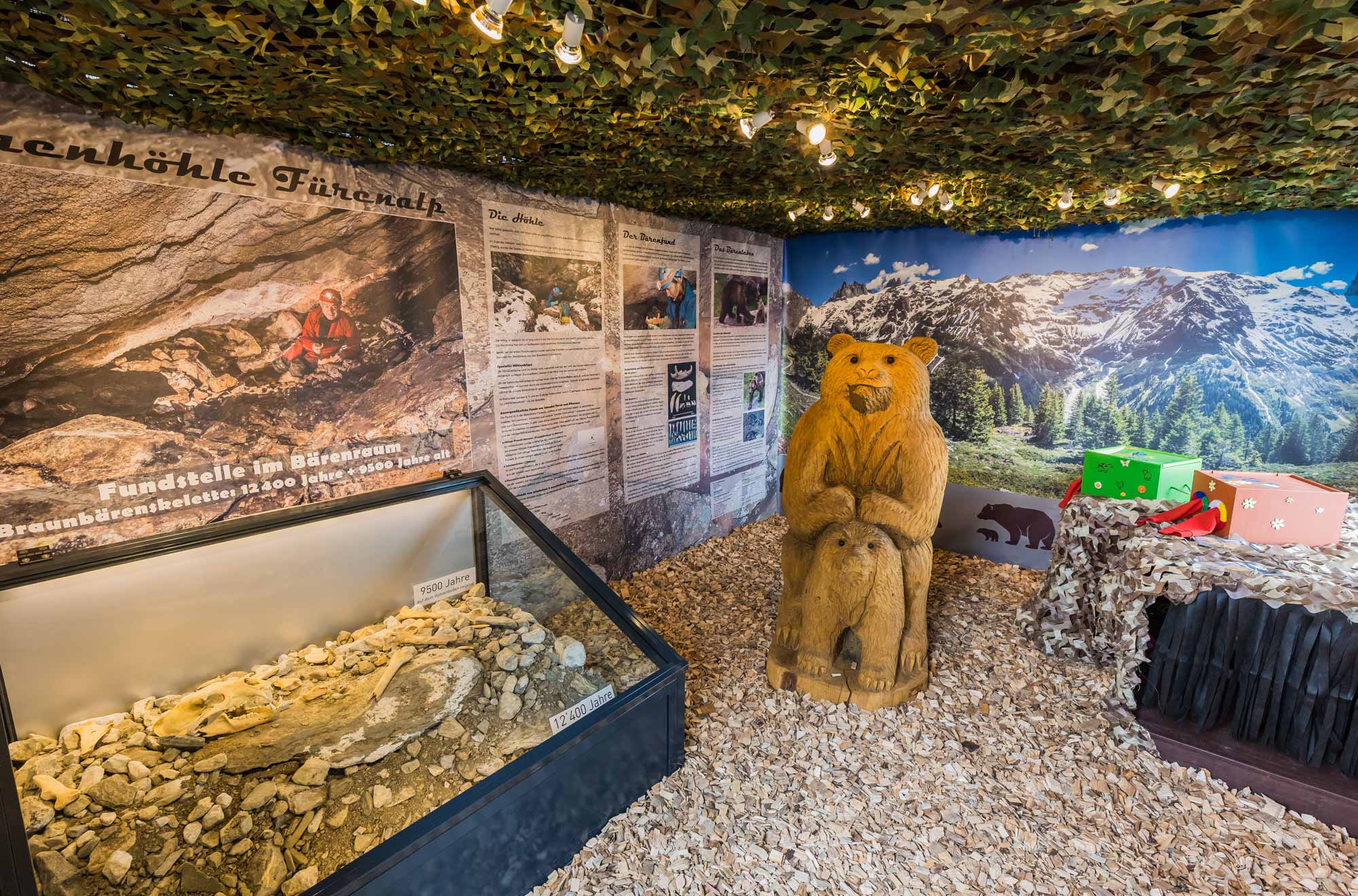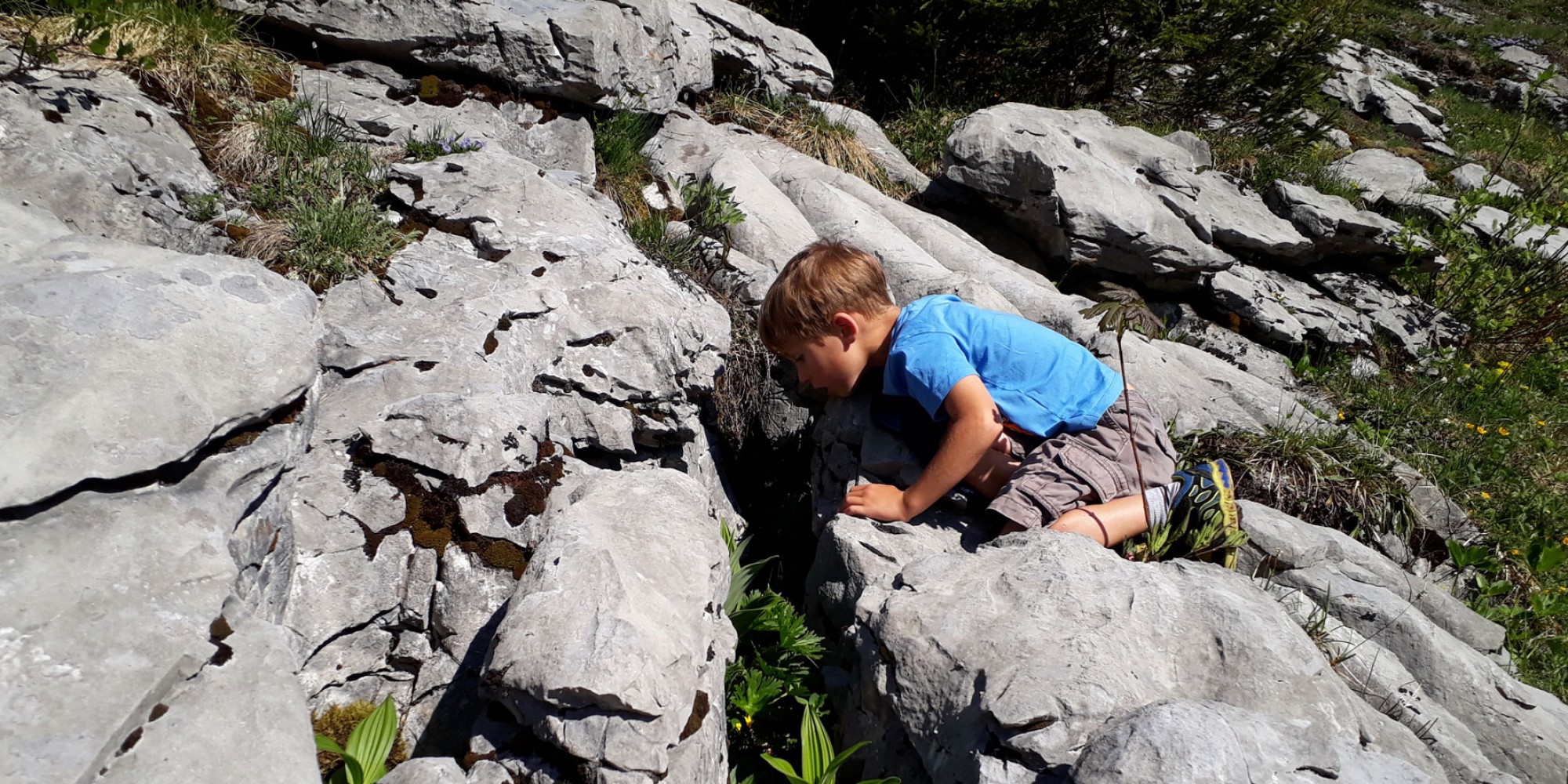Natural learning path Grotzli Walk
"Grotzli" are not strange, eerie figures, but are called young trees in the Engelberg dialect, in particular small spruces. When you set off around the circuit, you will marvel over nature's small miracles. The opportunity to learn something new is perfectly combined with leisure and relaxation!
The trail revolves around history, rocks, flora and fauna and alpine farming. The pleasant walkable circular path in the midst of the Engelberg High Alps combines active recreation with the opportunity to learn many interesting things. The easy walk along the nature trail and the variety of water, animals and flowers make the trail interesting for children and adults alike. The "Bear's Nest" exhibition shows the exciting discovery of the finds of brown bear bones that are over 12,400 and 9,500 years old.
Information

| Start/ End | Restaurant Fürenalp | |
| round trip | 3.4 km | |
| Altitude difference | 150 hm | |
| Duration | ca. 1.5 hours | |
| Section (Upper /Lower) | ca 45 minutes |

1 Floral splendour
The close dovetailing of the sites rich and poor in calcium is particularly noticeable in the Fürenalp area. It is not unsual that the ground composition changes inside a few meters and so changing the composition of the floral species. Fürenalp is distinguished by the unusually wide variety of plants found here from spring until autumn. (over 700 floral species).

2 Mountain Forest
The most important specie of tree which we find at the height of Fürenalp is the red fir tree. It is rare that the trees grow taller than 10m although they are often more than a few hundred years old. It takes thirty years and more for a young tree to grow half a meter. The fir trees grow close together in groups, so called “mobs”. In this way they protect themselves from the cold, wind and snow.
Also typical species in the upper treeline are dwarf shrubs, alpine rose (Rhododendron ferrugineum), blueberry or the Siberian Juniper (Juniperus sibirica).

3 Drop by drop
As soon as a mountain range rose above the sea level the energy of weathering started to have its effect. River carved valleys through the layers of rock. The cold and the water broke the stones. The weathering is easily recognisable around us, for instance on the pale high mountain limestone along the path. Rainwater washes away the calcium out of the stone leaving groves in the rock surface called karst.

4 Thundering in the night
The power of nature is still wearing down the mountains around us. In the early morning of 28th December 1961 50,000 - 70,000m3 of stone ( a volume equivalent to a 90 storey tower block) broke away from Klein Spannort and tumbled shattering over the mountain side. The rock buried the valley floor of the lower Surenen Alp and burst against the other side of the valley.

5 Monster on the Surenen
We find ourselves close to the border with the canton Uri and enjoy the view up to the Surenen Pass. The border between Engelberg and Uri has a colourful history - not least in the legend of the Uri bull.
"A shepherd on the Surenen treasured one of his young sheep so much that he wanted to christen it, like a person. He went over the Surenen to Attinghausen, taking a christening stone and christening water with him and baptised the lamb. Hardly had he done this a heavy storm broke out and the lamb turned into a terrible monster, which destroyed the shepherd’s hut and the shepherd himself. The Greiss - as the monster was called- tolerated neither people nor animals on the Surenen. The Engelbergers became fed up with the Alp and sold it cheapy to the Urners. But it didn’t go any better for them. A midget offered his advice as to how to slay the monster: They should let a silvery white calf suckle from a cow for seven years, and each year from on more cow. In this way the calf would become such a strong bull it could slay the Greiss. A young girl should then lead the bull by her hairband towards the Surenen and as soon as it could smell the Greiss she should untie it and turn around straight away, and was under no circumstances to look back. This all happened as the midget had instructed, however the young girl could not resist looking back out of sheer curiosity. A terrible rumbling arose and a pillar of smoke rose up into the sky. The Greiss was dead and the young girl was never to be seen again. The bull also lay dead in the alp stream , where he had drunk too greadily after the fight with the monster.
The area had been freed from the Greiss, but it still plied its dreadful trade in the heads of the Urners. Much later, when animals died unexplainably, one gave the Greiss the blame and the stream out of which the bull drank is still called “Bull Stream” (Stierenbach).

6 Fürenalp Marble
During this part of the path we are walking on a fascinating stone. It looks uninformed. The main part is whitish grey, often with yellow and green chunks. Between them are layers of iron rich slate and sandstone, which due to weathering have become red and green. This unusual stone which we call Fürenalp marble appears in few areas along the north edge of the Alps and is a siderolithische Brezkie (sideros= iron, lithos =stone, Brezkie=stone composed of angular pieces of rock). It is hardened kast filled with rubble from the weathering process which has been created over 50 million years ago

7 Glacier World
The Grotzliweg offers breathtaking views onto the glacial world on the other side of the valley. Glaciers crown the horizon between Titlis and Spannort. The highest point is described as the accumulation zone. The masses of ice flow lazily down towards the valley as tongues until they begin to melt in the warmer areas (ablation zone) turning into mountain streams tumbling down into the valley. Crevasses open up as the ice splits while it moves over bumps and drops. Ceracs are created as the glacier overcomes the high rock steps.
The thundering of ice blocks crashing down the valley can be heard as far away as Fürenalp.
8 Gummstein and its inhabitant
The imposing angular boulder, which the locals call Gummstein, is made of very rough, dark and compact sandstone. When one looks very closely, one sees that the surface is covered with a wide variety of lichen- especially in the areas where it stays moist. The yellow Rhizocarpon Ramond and the bright orange “goldkrusten” lichen are the first to be noticed.
Lichens are composite organisms consisting of a symbiotic association of a fungus (the mycobiont) with a photosynthetic partner. Thanks to the fungus, the lichen is able to photosynthesise, using light to make organic material.

9. Life on the alp
The alp season runs for three months from the beginning/ middle of June until ca. end of September. Hay is harvested from one area making supplies for the winter. 60 cows, 80 bullocks and 130 sheep live on Hinter (back) and Vorner (front) Fürenalp during the summer.
Many heavy storms destroyed the alp huts on Füren. In the alp hut you can find a stone, on these you can see the date of 1667 engraved.

10 Fürenalp cable car
A modern cable car has been running since 1979. Carrying a maximum of 8 people at a time it covers the 761 vertical meters in just 6 minutes. After the lift was completed the mountain restaurant was built. It has a capacity of seating 60 people inside, 30 people for banqueting and seminars and on the terrace they can seat 100 guests, as well as a playground for little ones.

11 Hundschaft an Panorama lake
Engelberg is quite simply heavenly! The Hundschaft Lake was mentioned in historical documents as a fantastic view point, even before Engelberg became a tourist magnet. Cast your eyes over the monastery village up to the sharp peaks of the mountains, which rise up majestically over the valley. Enjoy the unique mountain world as a mirror image in the Panorama Lake. In the little lake live many small animals such as the tadpole, frogs and salamander.

Exhibition "Bear`s Nest"
Who would have thought it? Behind such an inconspicuous crack in the rock lies a cave with such spectacular findings! How old could this bear be? Excavation with surprises - two of them lived on the Fürenalp 9500 and 12400 years ago. In particular, the oldest post-glacial brown bear found in Central Switzerland. The small but nice exhibition "Bear's Nest" gives an insight into the unique history of discovery and the life of a bear.



